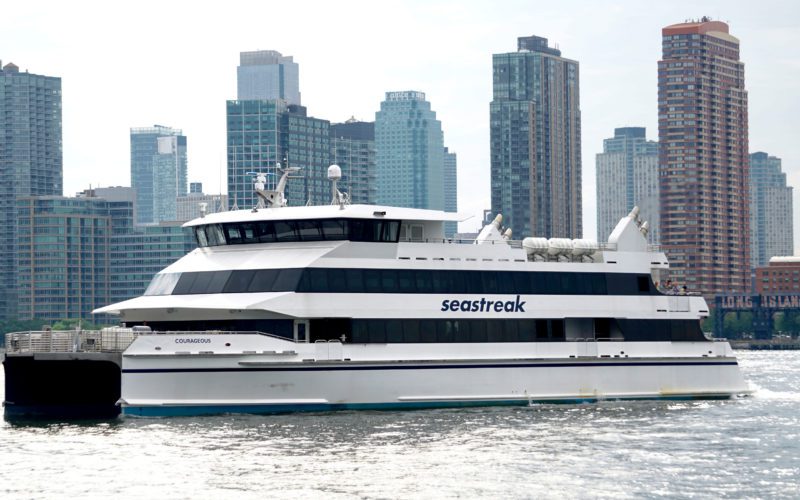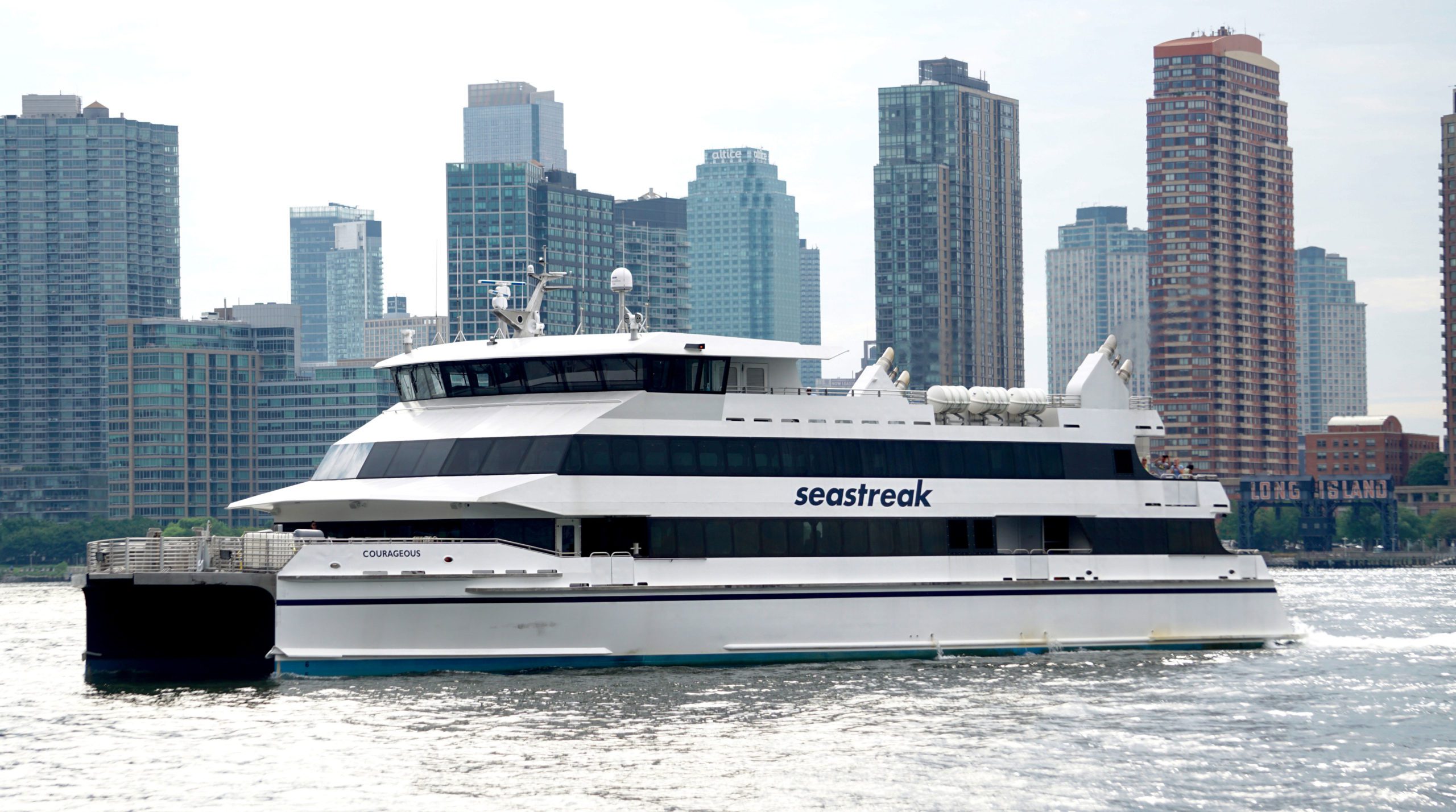
Courageous solidifies Seastreak’s fleet as more commuters return to the office
The East 35th Street ferry terminal in Midtown Manhattan can be a busy place during the morning rush hour as fast ferries loaded with commuters come and go every few minutes.
Amid this hive of activity, the 600-passenger Seastreak Courageous stood out on the horizon as it sailed up the East River. It made swooping U-turn, much like a jetliner on final approach, before docking starboard side-to the 35th Street terminal.
The 150-foot aluminum catamaran, a sister vessel to the 4-year-old Commodore, entered service in January 2022. Midship Marine of Harvey, La., built the vessel using an Incat Crowther design. The two vessels are the highest-capacity fast ferries operating in the United States.
Despite its size, Courageous is built for speed. It reaches 42 knots lightship and it cruises comfortably at 30 to 35 knots thanks to four MTU main engines paired with Kongsberg Kamewa waterjets. The commute from Atlantic Highlands, N.J., to Lower Manhattan takes only 35 minutes — saving time compared to rail or personal vehicle.
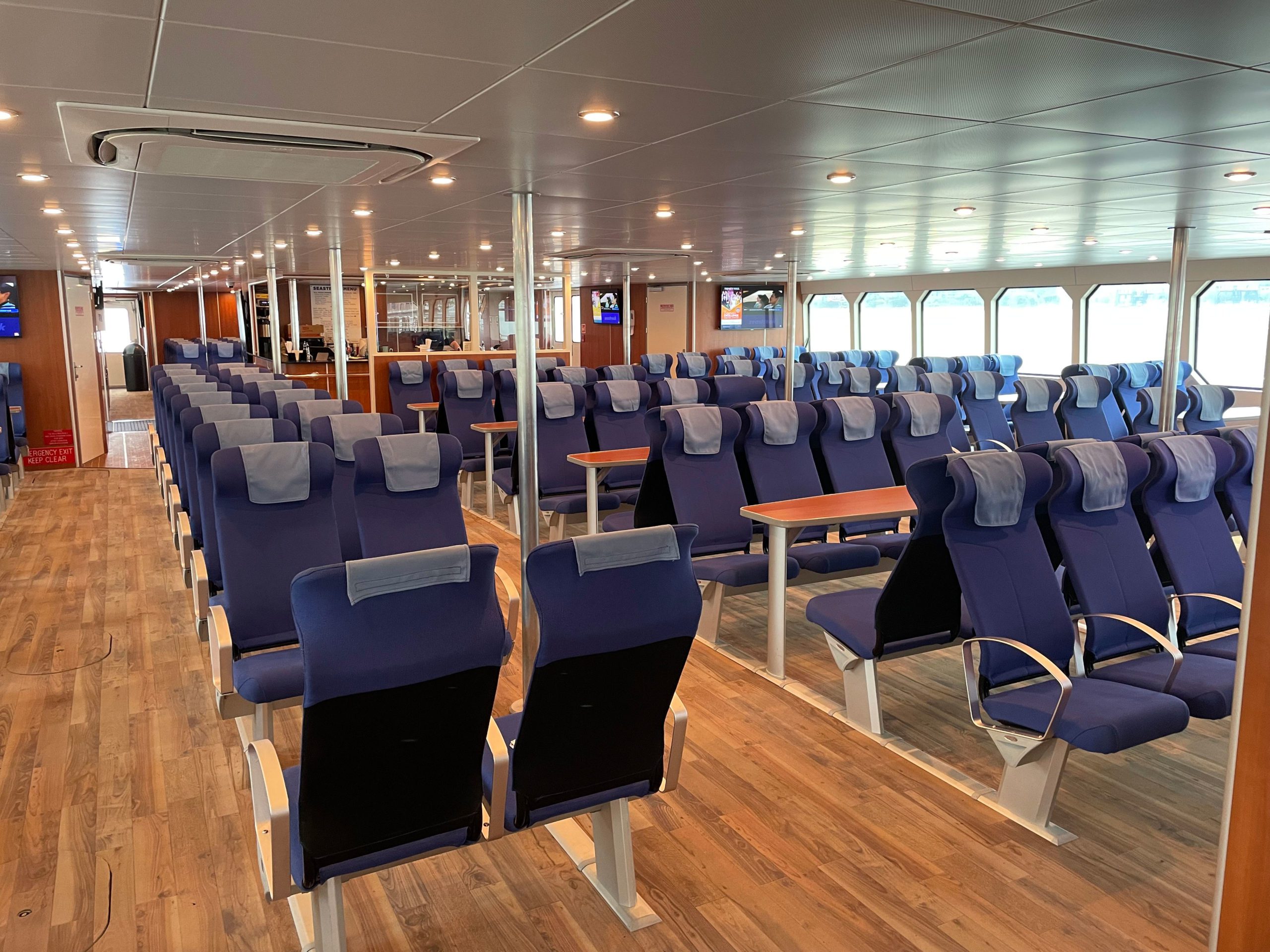
three decks, Courageous and its sister vessel Commodore are the two highest-capacity Subchapter K ferries operating in the U.S.
“We love the capacity and the space,” said Jack Bevins, the company’s vice president of operations and a licensed captain. “She’s just a robust ferry. She handles sea conditions very well.”
Seastreak’s Manhattan commuter fleet consists of Commodore and Courageous along with four 140-passenger high-speed catamarans that can accommodate 505 passengers. The company has historically connected Highlands and Atlantic Highlands with Pier 11 and 35 in Manhattan. The company recently won a contract to start service between Belford, N.J., and Manhattan in late October 2022.
Seastreak, which is based in Atlantic Highlands, N.J., operates sightseeing cruises up the Hudson River, whale watching excursions and weekend voyages to Martha’s Vineyard and Nantucket during the summer months. The company also operates vessels between Providence, R.I., and Martha’s Vineyard.
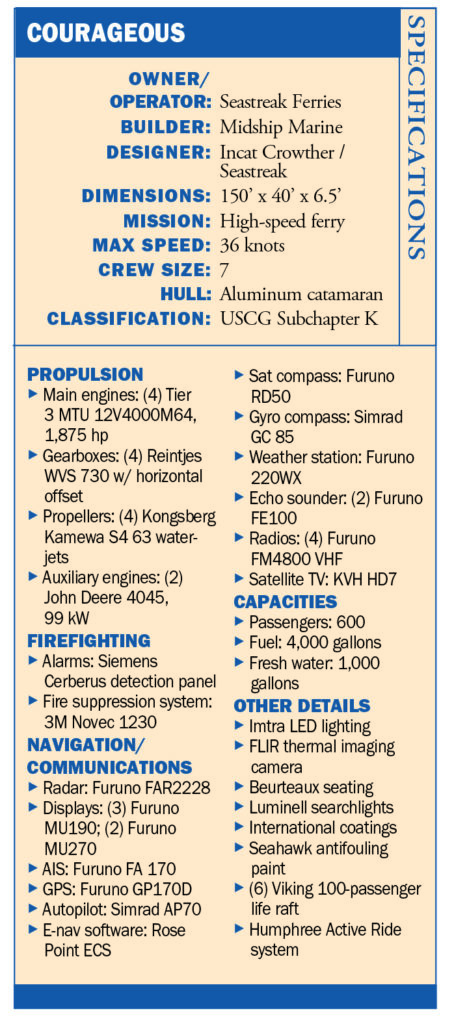 Plans for Courageous came together in mid-2019 following the delivery and successful operation of Commodore a year earlier. At that time, the company’s commuter business was approaching capacity during the weekdays. Courageous, the thinking went, would build capacity on those routes and facilitate further growth.
Plans for Courageous came together in mid-2019 following the delivery and successful operation of Commodore a year earlier. At that time, the company’s commuter business was approaching capacity during the weekdays. Courageous, the thinking went, would build capacity on those routes and facilitate further growth.
Six months later, with construction on the vessel well underway, the Covid-19 pandemic arrived in full force. Seastreak’s commuter ferries continued to operate throughout the pandemic, often with just a handful of riders on each run. Ridership remains below 2019 levels with the arrival of remote and hybrid work.
Ridership is rebounding, however, as more workers return to the office. Weekday capacity has exceeded 60 percent of 2019 levels on Tuesday through Thursday, Bevins said, while Mondays and Fridays remain a bit lower.
The design for Commodore and Courageous was a joint effort between Incat Crowther and Seastreak. Bevins worked closely with Brian Achille, Seastreak’s vice president of engineering, on a series of modifications to the initial plans. All told, the design went through more than 70 revisions, with many focused on enhancing the overall passenger experience.
For example, the vessel has seven heads spread across the two enclosed passenger decks to reduce wait times. It also has three zones for passenger loading and offloading, thereby minimizing idle time at the docks. One key difference on Courageous is an articulating brow on the bow to facilitate loading at a wide range of terminals, including the Steamship Authority dock in Martha’s Vineyard.
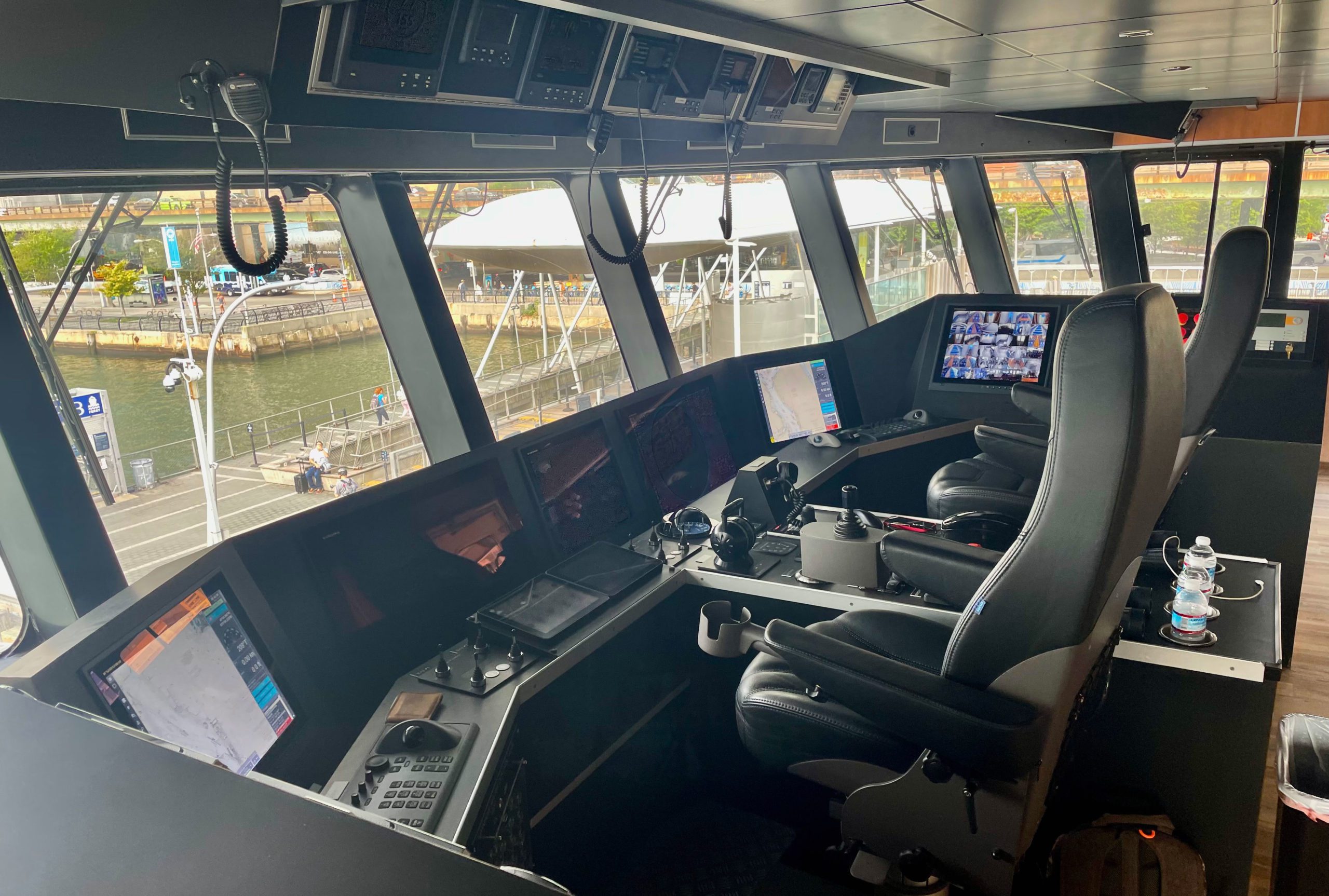
“We started off with a completely different design of the superstructure,” Bevins said. “Incat called her ‘boxy,’ but it works for moving commuters. We knew what we needed based on our operation and designed it around that.”
The finished product hit all the right notes around speed, performance and handling, according to Seastreak President Jim Barker. “When it was built, the boat did more than Incat Crowther promised us it would do,” he said. “Every boat we have built with an Incat Crowther design has exceeded our expectations in sea trials.”
The first level has a wide range of seating options, with some facing forward and others situated around shared tables. The space has a snack bar and numerous flat-screen TVs with a KVH satellite feed, along with electrical outlets every six feet along the exterior walls.
The second deck is known among riders as a place for peace and quiet, away from the conversations and socializing down below. It has hundreds of seats in an airline configuration and offers excellent views through tall forward-facing windows at the front. There is outdoor seating space located aft on the second deck.
One level up on the third deck, the vessel offers exterior seating with open-air views of the Manhattan skyline, the Statue of Liberty and other sights along the route. Beurteaux supplied the seating throughout the vessel.
The spacious bridge is equipped with a Furuno navigation suite that includes radar, AIS, GPS and depth sounder, while a Boning alarm panel quickly identifies mechanical faults as they arise. Seastreak installed a custom dash designed with ergonomics in mind. The setup is engineered for excellent views forward with key systems just below eye level.
“One goal of the layout was one to increase visibility for the operator,” said Bevins, who worked with Achille on the dash design. “And the other was the functionality for the controls and systems in the bridge. We considered human factors as we worked on the design.”
The port and starboard sides are equipped with helm stations that overhang the superstructure, offering clear views along the sides of the vessel. “That makes it really nice and safe for the captain to see not only when they are docking but also when we are loading passengers and they are observing what is going on during the embarkation,” Barker said.
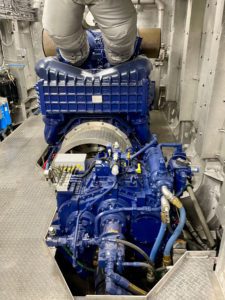
The engine rooms in each catamaran hull are spacious and well-lit. Propulsion comes from four 1,875-hp Tier 3 MTU 12-cylinder engines, with two installed in each hull. They drive Kongsberg Kamewa S4-63 mixed-flow waterjets through Reintjes WVS 730 diagonal offset reduction gears. Electrical power comes from 99-kW John Deere gensets supplied by R.A. Mitchell Co.
“Diagonal offsets allow a shafting arrangement that works well with a quad-screw catamaran,” said Chris Senner, vice president of sales and marketing for Reintjes supplier Karl Senner Inc. “It helps with the arrangement in the very narrow engine rooms in a catamaran.”
Other key features on the vessel include adjustable Imtra LED lighting throughout the vessel and a Humphree Ride Control system to improve passenger comfort during rougher weather.
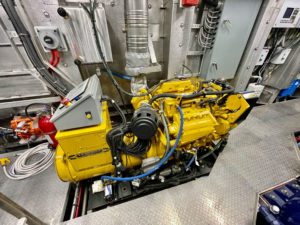
Courageous marks the first time Seastreak worked with Midship Marine on a new vessel, but not their first partnership. The company has used the Harvey, La., shipyard for repowers on its other fast ferries and found the shipyard responsive, capable and fair.
Midship built the vessel without a single change order and substantially under budget, Barker said. “We got a great boat for the money. If we were to build this today, it would cost significantly more than we paid for it.” •

